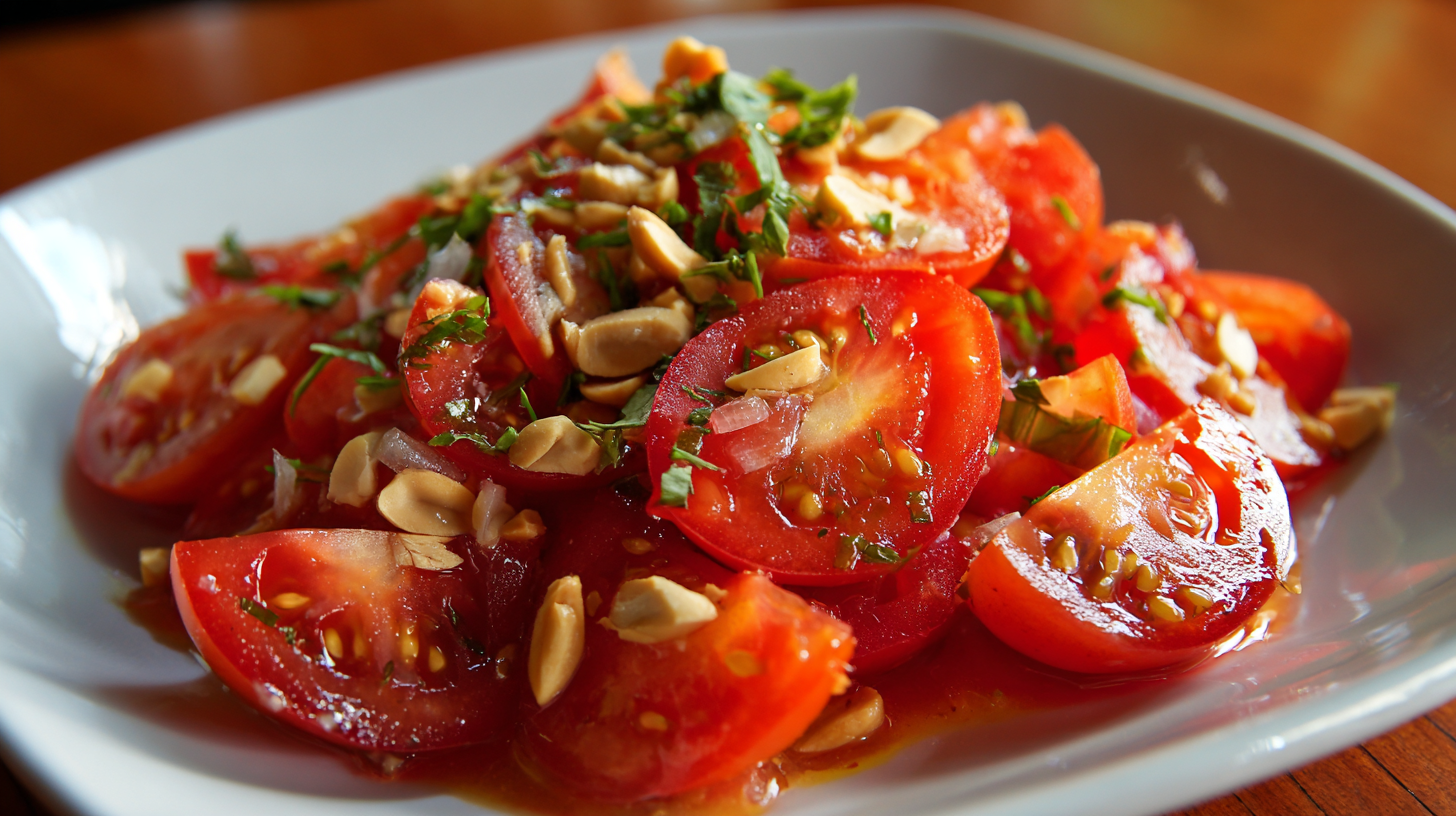When it comes to simple yet vibrant dishes, Burmese tomato salad steals the show. This refreshing salad, known as khow suey thoke in Myanmar, is a delightful mix of juicy tomatoes, crunchy peanuts, and aromatic shallots. It’s a perfect balance of flavors—tangy, nutty, and just a little spicy—that makes every bite irresistible.
What we love most about this dish is its versatility. It’s a quick side dish, a light lunch, or even a snack when we’re craving something fresh and flavorful. Plus, it’s a wonderful way to showcase ripe, in-season tomatoes. Whether you’re familiar with Burmese cuisine or just looking to try something new, this salad is an easy and delicious place to start.
Burmese Tomato Salad Overview
Burmese tomato salad, also known as khow suey thoke, is a refreshing and flavorful dish that showcases a medley of textures and tastes. This salad is built on fresh, ripe tomatoes paired with crunchy peanuts, aromatic shallots, and an irresistible dressing that brings everything together. It offers a balance of tangy, nutty, savory, and slightly spicy elements, creating a harmonious bite every time. The salad’s adaptability makes it perfect as a side dish, light meal, or snack. It’s also a wonderful way to enjoy seasonal produce while introducing diverse flavors to our table.
Whether served at gatherings or as a simple weekday meal, this salad is a true celebration of Burmese culinary tradition, highlighting bold ingredients and balanced seasoning. Let’s dig into how we bring these delicious components together.
Ingredients
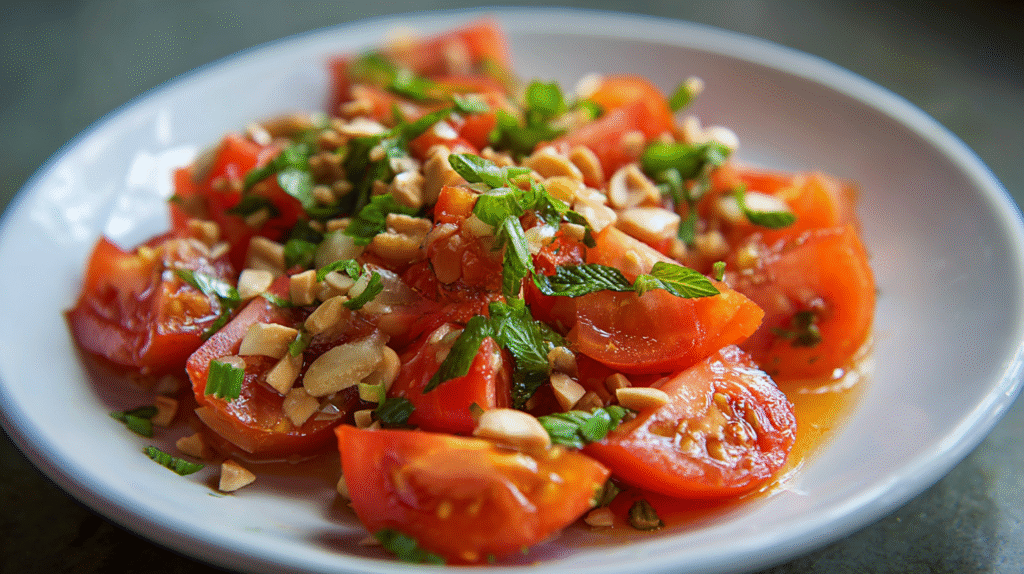
Here’s what we’ll need to create our flavorful Burmese tomato salad. Each ingredient plays a key role in delivering the iconic layers of taste and texture this dish is known for.
- Tomatoes: 2 medium green tomatoes, finely sliced. You can mix in 1 firm red tomato for added sweetness and color.
- Shallots: 2 small shallots, thinly sliced for a mild, sweet onion flavor.
- Garlic: 1 clove of garlic, minced or smashed to enhance the savory notes.
- Peanuts: 3 tablespoons of roasted peanuts, finely chopped or crushed for a nutty crunch.
- Fresh Peppers: 1 Thai bird chile or serrano chile, finely diced, for heat. For a milder option, use 1/4 red bell pepper, minced.
- Cilantro (optional): A handful of fresh cilantro leaves for garnish and a herbal aroma.
- Fish Sauce: 1 tablespoon for a punch of umami and saltiness.
- Lime Juice: 1 tablespoon of fresh lime juice to bring out the tangy balance.
- Vegetable Oil: 1 teaspoon, lightly drizzled, to integrate all the flavors.
- Salt: Pinch of salt to taste, adjusting for balance.
Tools And Equipment
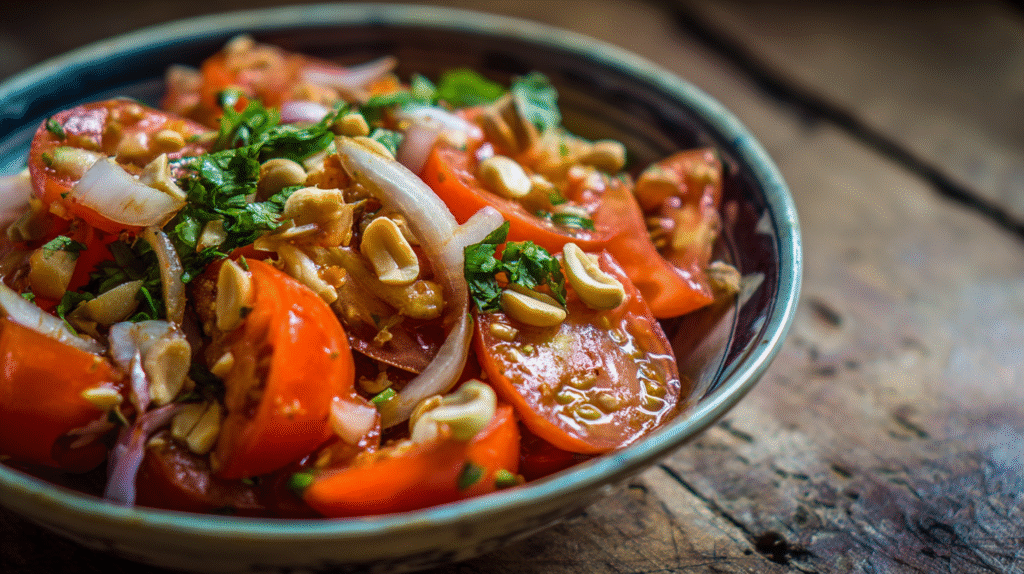
To create the perfect Burmese Tomato Salad, having the right tools and equipment on hand is essential. Here’s what we’ll need and how we’ll use each item:
Cooking and Preparation Tools
- Small frypan or dry skillet: We’ll use this to toast the sesame seeds, chickpea flour, and peanuts. This step enhances the nutty flavor of the ingredients.
- Saucepan: If we want to add crispy shallots to our salad, we’ll fry them in a saucepan to achieve a golden, crunchy texture.
- Fine-mesh sieve: After frying shallots, we’ll drain them using the sieve to remove excess oil. This ensures they stay crisp without becoming greasy.
- Paper towel-lined plate: Once the shallots are drained, we’ll transfer them to a plate lined with paper towels. This step helps them cool and crisp up further.
- Cutting board and knife: Essential for chopping tomatoes, onions, garlic, coriander, and chilies. A sharp knife and a sturdy cutting board make this process easy and efficient.
Mixing and Serving Tools
- Large bowl: A big mixing bowl will be key for tossing all the ingredients together. It allows even distribution of flavors while keeping the process mess-free.
- Spoons or fingers: Burmese Tomato Salad is best mixed gently to maintain the integrity of the delicate ingredients. We’ll use spoons or even our fingers for the lightest touch.
Other Equipment
- Ice water bowl: Shallots can have a strong pungency, so soaking them in ice water before using them helps mellow their flavor.
- Vegetable oil or peanut oil: If frying shallots or peanuts, good-quality oil like vegetable or peanut oil will ensure the best taste and texture.
Directions
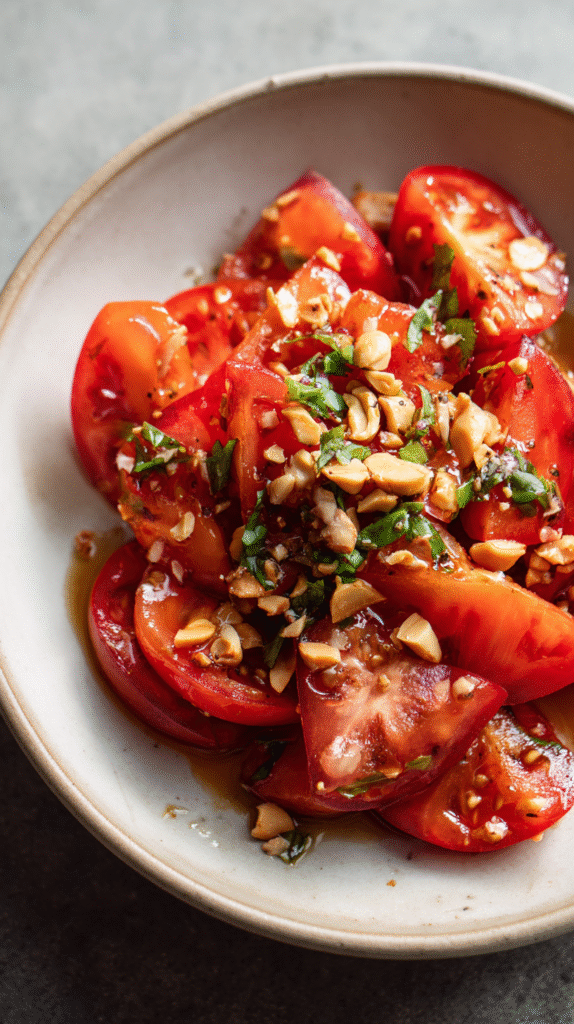
Let’s bring this vibrant Burmese Tomato Salad to life. Follow these simple steps to create a flavorful, balanced dish that’s sure to impress.
Prep The Ingredients
- Slice the green tomatoes into thin wedges or slices. If using a mix of tomatoes, cut them accordingly for uniformity.
- Thinly slice the shallots into rounds, then soak them in a bowl of ice water for a few minutes to reduce their pungency. Drain and set aside.
- Slice the peppers into thin rings or rounds. Depending on your spice tolerance, you can opt for Thai bird chiles, serrano chiles, or milder red bell peppers.
- Mince the garlic or smash it flat using the blunt side of a knife.
Prepare The Dressing
- In a small bowl, combine 2 tablespoons of lime juice, 1 tablespoon of fish sauce, and 1 teaspoon of vegetable oil.
- Add a pinch of salt and gently stir to mix. Taste and adjust the seasoning as needed to balance the tangy, salty flavors.
Combine The Salad
- In a large mixing bowl, layer the prepared tomatoes, shallots, peppers, and garlic.
- Add a handful of crushed, roasted peanuts for crunch and texture.
- Drizzle the dressing over the salad and gently toss with spoons or your clean hands to coat all ingredients evenly.
- Finally, garnish with fresh cilantro leaves before serving.
Tips For The Perfect Burmese Tomato Salad
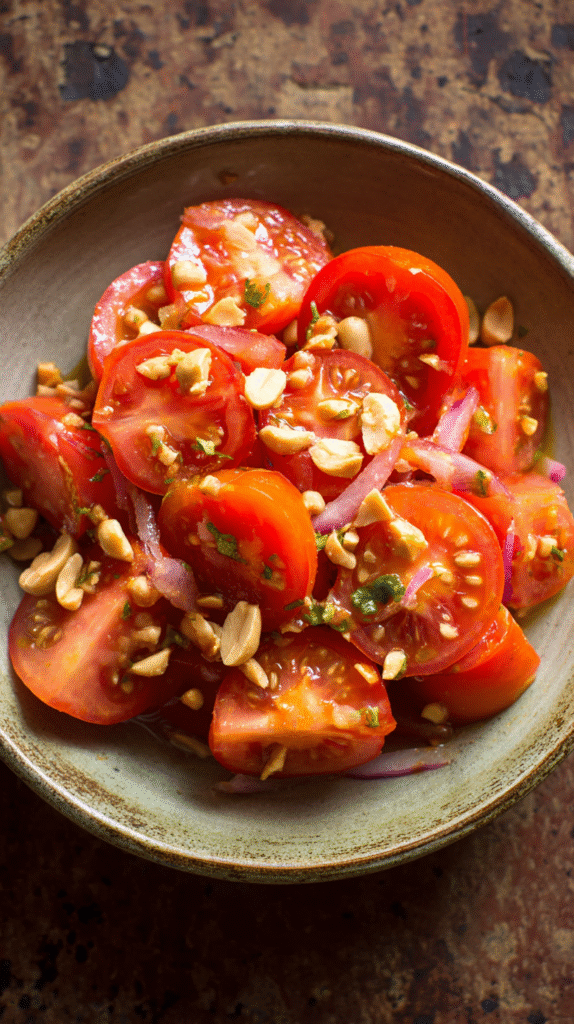
To create the most flavorful and authentic Burmese tomato salad, it’s all in the details. Here are a few essential tips for making this dish truly exceptional.
1. Use Green Tomatoes for Tartness
Green tomatoes are the ideal choice for their tart flavor and crisp texture. If green tomatoes are unavailable, opt for firm red tomatoes to avoid overly soft pieces. Slice them evenly for consistent bites in the salad.
2. Soften Shallots for Balance
Thinly slicing the shallots and soaking them in ice water for 10–15 minutes reduces their sharpness while maintaining their crunch. This step keeps the onion flavor balanced and ensures it doesn’t overpower the other ingredients.
3. Choose Fresh Peppers
Incorporate fresh, vibrant peppers like Thai bird chiles or jalapeños for the perfect level of heat. Mince them finely to allow their spiciness to distribute evenly across the salad.
4. Crush the Peanuts Lightly
Rather than fully grinding the roasted peanuts, crush them lightly to add texture and a satisfying crunch. A mortar and pestle or a quick press with the back of a knife works great.
5. Balance the Dressing Flavors
The dressing is critical to achieving the dish’s signature taste. Use fresh lime juice for its tangy brightness, good-quality fish sauce for depth, and a light vegetable oil to tie the flavors together. Taste the dressing before tossing to ensure the perfect balance of salty, tangy, and savory.
6. Garnish with Herbs Generously
Herbs are not just a garnish—they bring fragrance and flavor. Use a mix of cilantro, fresh mint, and coriander to add depth. Tear the herbs gently instead of chopping to preserve their aromatic oils.
7. Mix Gently
When combining your ingredients, toss them gently to avoid bruising the tomatoes. A light hand is all it takes to coat the salad evenly with the dressing.
8. Serve Fresh
For the best experience, serve the salad immediately after preparation. This keeps the textures crisp and the flavors vibrant, ensuring your salad remains as refreshing as intended.
Variations And Additions

Burmese tomato salad is as versatile as it is flavorful, allowing us to experiment with different ingredients and tailor it to our preferences. Whether we want more tanginess, crunch, or spiciness, there are numerous variations and additions we can explore.
Peppers
For those who enjoy extra heat, we can swap out our traditional Thai bird chiles for serrano peppers or jalapeños. If a milder flavor is preferred, diced red bell peppers work beautifully. The subtle sweetness of red bell peppers pairs well with the tangy tomatoes, offering us a gentler kick.
Onions and Shallots
While small sweet onions or shallots provide a sharp yet aromatic edge, soaking them in cold water softens their intensity. This tweak ensures that their flavor complements the dish without overpowering it. We can also caramelize the shallots for a sweeter, deeper flavor addition.
Nuts and Seeds
Roasted peanuts are a classic choice, but we can experiment with other varieties like pistachios or even sesame seeds for added crunch and nutty undertones. Lightly crushing the nuts enhances their texture, creating satisfying bursts of flavor in every bite.
Tomatoes
Green tomatoes are the cornerstone of this salad, loved for their tartness and firm texture. However, if green tomatoes are unavailable, underripe red tomatoes are a reliable substitute as they provide a similar crispiness and tang.
Herbs
Cilantro is the go-to herb for this salad, but adding fresh mint or Thai basil can elevate the dish with unexpected aromatic notes. A mix of herbs ensures a refreshing and layered flavor profile.
Dressing Enhancements
The lime juice and fish sauce-based dressing can be adjusted to cater to our taste. For additional umami, we can incorporate a dash of tamarind paste or a splash of soy sauce. Adding a touch of palm sugar balances out the acidity and saltiness, making the salad even more well-rounded.
Serving Suggestions
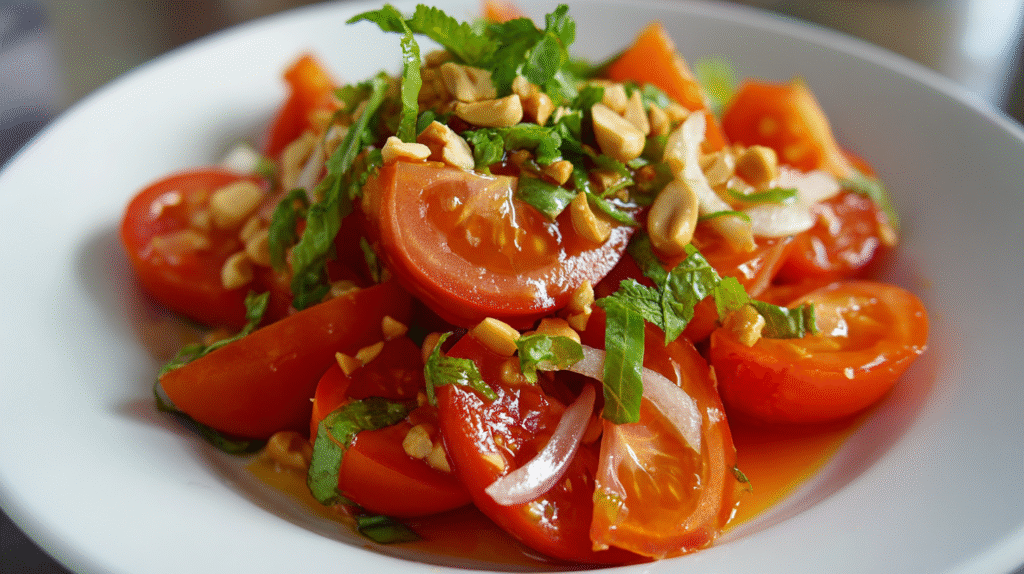
Burmese tomato salad shines in its versatility, making it a delightful addition to various meals and occasions. Let’s explore a few ways we can serve and enjoy this vibrant dish:
As a Side Dish
This salad pairs beautifully with rich, flavorful curries or steamed rice. The fresh, tangy tomatoes and crunchy peanuts contrast perfectly with the creamy and hearty textures of a curry. Served alongside a hot bowl of rice, it provides a refreshing element that balances the meal. It’s an easy way to elevate a traditional family dinner.
With Grains
For a well-rounded yet light meal, we recommend serving the salad with grains like noodles or quinoa. The salad blends harmoniously with the soft texture of noodles, creating a dish that is both satisfying and light — ideal for hot summer days when heavy meals feel overwhelming.
As a Light Meal
Burmese tomato salad makes a fantastic lunch option when served on its own. For a heartier version, we can add deep-fried tofu or slices of boiled eggs for an extra boost of protein. This transforms the salad into a nourishing meal that still feels light and refreshing.
For Gatherings and Potlucks
This salad’s vibrant colors and bold flavors make it a crowd-pleaser at potlucks or family gatherings. It’s easy to prepare in large quantities, and the mix of tangy, nutty, and spicy flavors is sure to impress guests. Serve it in a wide, shallow bowl to showcase its visual appeal and make it easy for everyone to grab a portion.
By thoughtfully selecting how we serve this salad, we can enjoy its versatility and enhance various meals with its fresh, bold flavors.
Make-Ahead Instructions
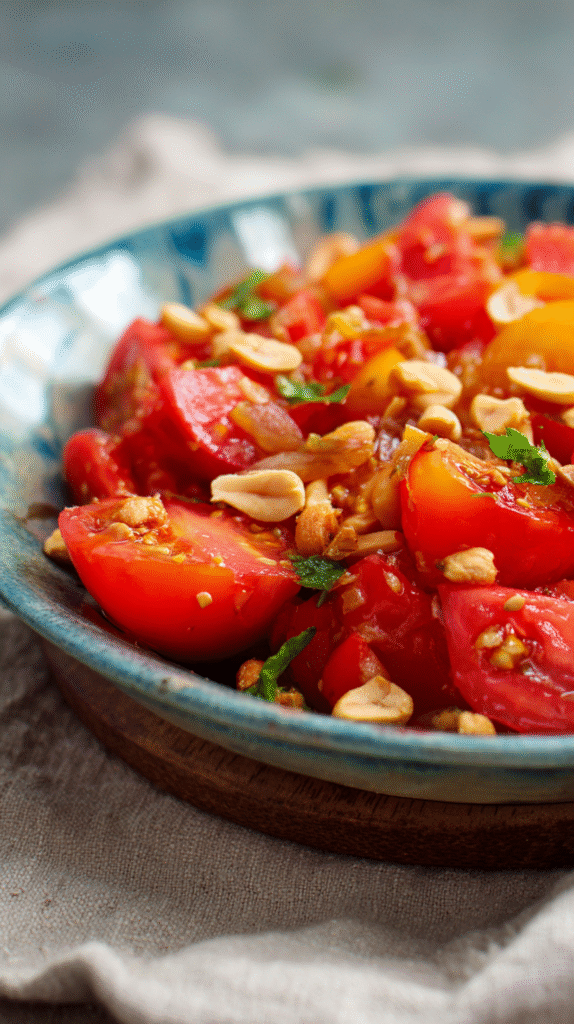
Preparing components for our Burmese tomato salad ahead of time can save effort and enhance the flavors when it’s time to assemble the dish. Here’s how we can organize and streamline the process:
Toasting and Roasting
- Sesame Seeds and Chickpea Flour: Place a small, dry skillet over medium heat and add the sesame seeds or chickpea flour. Stir frequently to prevent burning, and toast until they turn lightly golden and release a nutty aroma. Remove them from the heat and let them cool completely before storing them in an airtight container.
- Peanuts: If we’re starting with raw peanuts, spread them in an even layer on a baking sheet. Roast them in a preheated oven at 350°F for about 10-12 minutes or until golden. Once cooled, crush the peanuts lightly to maintain texture and store them in a sealed container, ready for garnishing.
Preparing Components
- Fried Garlic and Shallots: Slice the garlic and shallots thinly and fry them in a small saucepan with vegetable oil over medium heat. Stir frequently until they are crispy and golden brown. Drain on a paper towel-lined plate to maintain crispiness, then store in a container lined with paper towels to absorb any remaining oil.
- Herbs and Peppers: Chop the cilantro and chilies ahead, ensuring they are fresh and finely prepared. Transfer them to separate airtight containers or small resealable bags, keeping them in the refrigerator until needed.
- Lime Juice and Dressing Base: Juice a few limes and store their juice in a sealed jar. We can also pre-mix portions of the dressing base—combine fish sauce, lime juice, and a dash of salt—and store it in the fridge. Add vegetable oil and toss the dressing just before using for the freshest flavor.
By making these elements in advance, we can quickly assemble the Burmese tomato salad when it’s time to serve, ensuring its vibrant flavors and textures come together seamlessly.
Conclusion
Burmese tomato salad is more than just a dish; it’s a vibrant celebration of fresh ingredients and bold flavors. Whether we’re preparing it for a cozy meal at home or a lively gathering, its versatility and charm never fail to impress.
With its perfect balance of tangy, nutty, and spicy notes, this salad invites us to explore the beauty of Burmese cuisine in a simple yet unforgettable way. Let’s embrace the joy of creating and sharing this flavorful dish with those we love.
Frequently Asked Questions
What is Burmese Tomato Salad made of?
Burmese Tomato Salad, or khow suey thoke, is made with ingredients like green tomatoes, shallots, garlic, roasted peanuts, fresh peppers, cilantro, fish sauce, lime juice, vegetable oil, and salt. Its blend of tart tomatoes, savory seasonings, and crunchy textures makes it a flavorful dish.
What does Burmese Tomato Salad taste like?
This salad has a tangy, nutty, and slightly spicy flavor. The combination of juicy tomatoes, citrusy lime, savory fish sauce, and crunchy peanuts creates a perfectly balanced and refreshing dish.
Can I customize the Burmese Tomato Salad?
Yes! You can customize it by adjusting the heat with different peppers, using alternative nuts for crunch, or adding herbs like mint or Thai basil. Enhancements like tamarind paste or palm sugar can also adjust the dressing’s flavor profile.
What tomatoes should I use for this salad?
Green tomatoes are ideal for their tartness, but underripe red tomatoes can be a substitute if green ones are unavailable. Avoid very ripe tomatoes to maintain the salad’s texture and balance.
Can I prepare Burmese Tomato Salad in advance?
You can prep parts of the salad in advance. Toast the peanuts, fry the shallots, and mix the dressing beforehand. However, the salad is best assembled fresh to preserve its vibrant flavor and texture.
What should I serve with Burmese Tomato Salad?
Burmese Tomato Salad pairs well with rich curries, steamed rice, or noodles. It can also be served alone as a light meal with tofu or boiled eggs for added protein.
Can this salad be made vegetarian or vegan?
Yes! To make it vegetarian or vegan, replace the fish sauce with soy sauce or tamari. This adjustment keeps the dish flavorful while meeting dietary preferences.
How do I make the dressing for Burmese Tomato Salad?
The dressing is simple! Combine lime juice, fish sauce (or soy sauce for a vegan option), vegetable oil, and salt. Adjust the amounts to balance acidity, saltiness, and richness.
What are some tips for the best Burmese Tomato Salad?
Soak shallots in ice water to reduce sharpness, lightly crush the peanuts for texture, and gently toss the salad to avoid bruising the tomatoes. Garnish generously with fresh herbs and serve immediately for the best experience.
Is Burmese Tomato Salad a traditional dish?
Yes, Burmese Tomato Salad is a traditional dish that highlights the rich culinary heritage of Burma. It’s known for its bold flavors, simple ingredients, and adaptability to different occasions.
Can I make this salad spicier?
Absolutely! Add more fresh peppers like serrano or bird’s eye chilies to amp up the heat. You can also experiment with spicy oils or seasonings to match your spice preference.
How can I make the salad stand out at a gathering?
Use fresh, high-quality ingredients for vibrant flavors and color. Garnish with extra herbs or toasted nuts, and serve it alongside complementing dishes like curries or rice for a standout presentation at gatherings.
